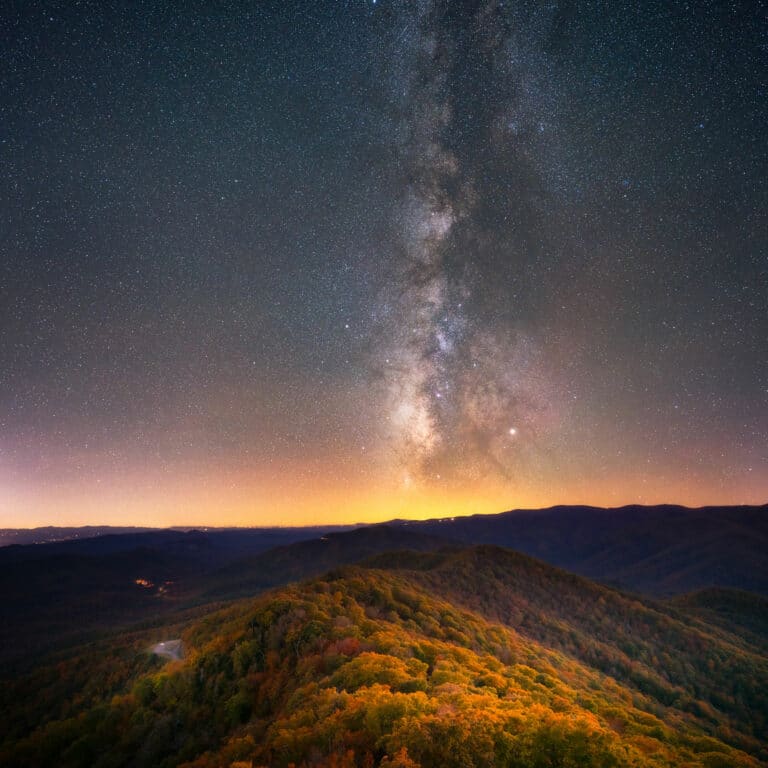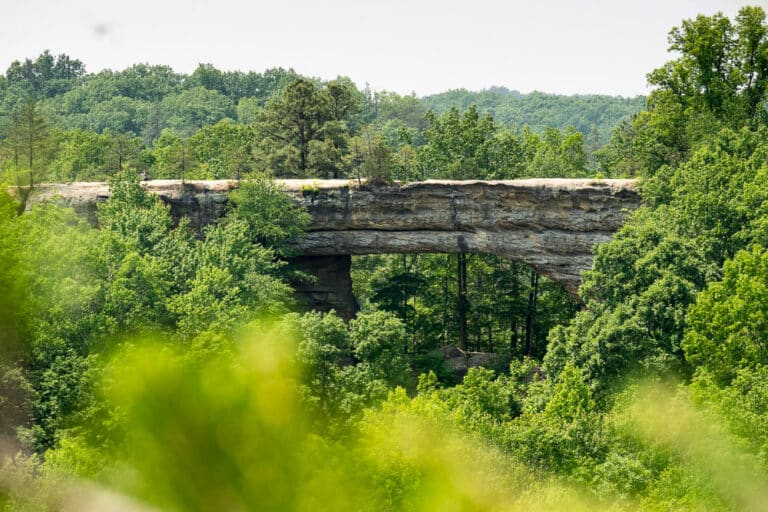Greenest Town:
Fayetteville, W.Va.
On a plateau above New River Gorge National River Recreation Area in West Virginia, Fayetteville is an all-natural playground. In the last decade, a wave of adrenaline junkies has come to the southern West Virginia town for work (mostly as river rafting guides) and opted to stay for good. Epic whitewater rafting, classic rock climbing, and endless trails make Fayetteville one of the greenest spots on the map.
Runners-Up: Charlottesville, Va., Carrboro-Chapel Hill, N.C., Salem-Roanoke, Va., Athens, Ga.
—————
Greenest Trend: BYOB (Bring Your Own Bag)
The plastic bag ban has been catching on in progressive countries across the globe for years. Ireland issues a 37-cent tax on every plastic bag used. Stores in Germany have to pay a recycling fee if they want to use plastic bags. An outright ban in China is expected to save that country 37 million barrels of oil each year. In March, 2007, San Francisco became the first city in America to ban the use of plastic bags in retail stores. Before the ban, San Francisco used 180 million plastic bags each year. The ban cut the city’s plastic bag use by five million each month. Several other American cities are now entertaining a ban on plastic bags, which would drastically reduce this country’s petroleum use while also cutting down on landfill fodder (the bags aren’t biodegradable). It takes 430,000 gallons of oil to produce 100 million plastic bags. Worldwide, five trillion plastic bags are used every year.
Runners-Up
• 100 Mile Diet: Each ingredient on your plate traveled an average of 1,500 miles to get there. The amount of petroleum it takes to transport our food from the farm to our bellies is ridiculous, so many individuals have established a diet based on food that originates from a source within 100 miles or less. Several 100-mile restaurants have opened in the Southeast, and individuals are striving to find local farmers to help reduce their food miles. Studies show a regional diet consumes 17 times less oil and gas than a standard diet. www.100milediet.org.
• Save Our Slopes: A moratorium on large scale development in the Southern Appalachians? It is possible. Several city and county governments are considering an official pause in the housing development boom that’s currently wreaking havoc on our mountains. The pause would allow those governments to establish sensible environmental and growth plans before all our slopes are consumed by high-end neighborhoods. www.saveourslopes.org.
• Water, Hold the Cancer: BPA—short for bisphenol A—is a compound found in polycarbonate plastics that some studies have shown mimics the hormone estrogen and can cause medical ills in lab rats. Thankfully, Nalgene, Camelbak, and other water bottle manufacturers are introducing BPA-free bottles. Klean Kanteen and other stainless steel water bottles are even better, as they last longer and use no petrochemical plastics.
—————
Greenest Gear: USED GEAR
It doesn’t matter if your new skis are made from bamboo and your bike shorts are organic cotton, the greenest gear you can find is something that’s already been made. Keep used gear out of the landfill and help lower the production of unnecessary gear by shopping at second-hand gear stores, buying used, or trading your old bike for a skateboard on gear trading sites like geartrade.com.
Runners-Up: Everlite’s solar-powered headlamp makes your outdoor adventure even more eco-friendly. A six-hour solar charge provides powerful, plentiful all-night LED light. Patagonia uses 100 percent organic cotton in all of its clothing, and it re-uses customers’ discarded clothing by melting them down to use the raw materials in new jackets and sweaters. Terra Cycle collects trash and turns it into viable goods. Their ultimate goal is to eliminate waste completely by making functional gear and products out of discarded energy bar wrappers and drink containers. Timberland makes sneakers with vegetable- (instead of chemical-) tanned leather and recently launched a Green Index to measure each product’s environmental footprint.
—————
Greenest Victories of ‘08: MERCURY RULE
In February, a federal judge ruled that coal-fired power plants must control mercury emissions. The ruling requires the EPA to develop tougher standards for mercury and other toxic pollutants from power plants.
Runners-Up
• Naval landing field nixed—A six-year fight against the Navy’s proposal to build an outlying landing field in eastern North Carolina adjacent to a wildlife refuge engaged the support of over 100 regional organizations. Thanks to their persistence, the Navy withdrew its proposal.
• Dead-end for Road to Nowhere—Congress agreed to fund a cash settlement to local residents instead of building an ecologically destructive road through the Smokies.
• Uranium mining study stopped—Virginia’s lawmakers killed a bill that would have opened the door for uranium mining to resume in Virginia.
• Tellico trails saved—The Forest Service agreed to seasonal closures of the Upper Tellico ORV area and to restore at least four other trails that have eroded and polluted the Tellico River headwaters.
• MTR Coal Ban Bill—The Appalachian Mountains Preservation Act was introduced in North Carolina, thanks to the hard work of Appalachian Voices and ilovemountains.org. The bill would make North Carolina the first state in the nation to ban the use of coal obtained from mountaintop removal mining.
• Blair Mountain saved—The United Mine Workers, the West Virginia State Legislature, and dozens of environmental and public health groups worked together to preserve 1600 acres of the Blair Mountain Battlefield as a National Historic Site. Several coal companies owned mineral rights to the area and had planned on expanding a nearby mountaintop removal mine site.
—————
Greenest Destination: OKEFENOKEE NATIONAL WILDLIFE REFUGE
The Okefenokee wins the Greenest Destination award simply because of its size. The refuge is 402,000 acres, spans 700 square miles, and includes a 354,000-acre federally designated Wilderness area. By far, the Okefenokee is the largest Wilderness in the Eastern United States. The 7,000-year old peat-filled bog sits inside a saucer-shaped depression on the Georgia/Florida border, and is home to 233 species of birds, 49 species of mammals, 64 species of reptiles, 37 species of amphibians, and 39 species of fish. There are even carnivorous plants. Paddle the Okefenokee Wilderness (no hiking trails exist in the Wilderness area) and you are no longer the highest member of the food chain—a humbling experience that reinforces environmental morals.
Runner-Up
• Your Community Trails: The greenest outdoor destination is one you don’t have to travel far to enjoy. You may not have epic singletrack beginning from your doorstep, but most towns offer systems of parks, greenways, and waterways perfect for after-work adventure.
—————
Greenest College: WARREN WILSON COLLEGE
Located in Swannanoa, N.C., the small college is almost entirely self-supporting, getting much of its food and lumber from sustainably managed farmland and forests. The school boasts LEED-certified buildings, an organic farm, and a service-learning program where students manage recycling, gardening, trails, and other aspects of campus life. It is the first school in the Southeast to offset all of its energy use with renewable energy credits. The Sierra Club ranked Warren Wilson tops in the Southeast for fighting global warming, and Outside Magazine named Warren Wilson to its top 40 list of schools that turn out smart grads with top-notch academic credentials, a healthy environmental ethos, and an A+ sense of adventure.
Runner-Up: University of Maryland—91 percent of undergrads voted to raise student fees in order to pay for clean energy. If implemented, the fee increase would make Universty of Maryland the largest higher-ed purchaser of renewable energy in the U.S.
—————
Greenest Legislation: RENEWABLE ENERGY AND CONSERVATION ACT OF 2008
This is the bill that could provide the green energy infrastructure that America so desperately needs. The bill repeals $18 billion in tax subsidies for oil companies, money which would then be invested in renewable energy development like solar and wind projects. Invest in solar or wind energy and reap a 30% investment tax credit. It’s estimated the bill would create 70,000 jobs in the solar industry alone.
Runners-Up
• National Renewable Electricity Standard: This bill would require 20% of our nation’s electricity be generated by renewable sources like wind, solar, biomass, and geothermal by 2020, effectively reducing greenhouse gas emissions by 233 million tons.
• The Wilderness Bills: The Consolidated Natural Resources Act has passed both the House and Senate and has been signed into law by President Bush, establishing the 106,000-acre Wild Sky Wilderness area in Washington State. Three other Wilderness bills are currently being fast-tracked through Congress that will establish new Wilderness areas in Virginia, West Virginia, and Oregon. Several other Wilderness bills have been introduced during this session, signaling a revitalization of the America’s highest form of land protection.
—————
Greenest Music Festival: SHAKORI HILLS GRASSROOTS MUSIC AND DANCE FESTIVAL
This not-for-profit, community-run festival takes place on a 75-acre farmstead with ancient oaks and rolling meadows just outside of Chapel Hill, N.C. The Festival offers a biodiesel shuttle for attendees throughout the Triangle area, and its sustainability fair highlights regional environmental initiatives and education.
Runner-Up: Bonnaroo hosts eco-speakers and performers, uses post-consumer recycled paper, biodegradable concession service items, cleaner fuel options, and has onsite composting and recycling options. Planet Roo is a tent full of practical and inspiring ways to green your life.
—————
Greenest Restaurant: THE HARVEST TABLE
You can’t get guacamole for your quesadilla at The Harvest Table in Meadowview, Va. Why? Because avocados don’t grow in Virginia. The new restaurant, which opened last October, is located in the small town of Meadowview. The menu is prepared with only what chef Philip Newton can get from local farmers and vendors. It makes for a few challenges, but it’s all in the name of sustaining his local community in Southwest Virginia. “Everything at least has a local connection,” Newton says. ”Anything that’s a main entrée comes from right around here.”
Keeping it local comes with its share of difficulties. The menu at Harvest Table has to constantly change based on availability, and Newton has been forced to learn a few new tricks that weren’t taught in culinary school.
“I’m having to buy whole animals and help farmers cut things down,” he says. “We’re still working out all the kinks, but it’s getting easier.”
Runners-Up: Rosetta’s Kitchen, Asheville, N.C.; Fork in the Alley, Roanoke, Va.; Restaurant Nora, Washington, D.C.; Flying Biscuit, Atlanta, Ga.; Soul Vegetarian, Atlanta, Ga.; Revolutionary Soup, Charlottesville, Va.; Java Green, Washington, D.C.; The Grit, Athens, Ga.
—————
Greenest Regional Business: POLYFACE FARM
In 1961, the Salatin family purchased a worn-out, eroded, abused farm near Staunton, Va. Using nature as a pattern for their farm, the Salatins planted trees, built huge compost piles, dug ponds, moved cows daily with portable electric fencing, and invented portable sheltering systems to feed all their animals on perennial prairie polycultures. Today Polyface Farm is the country’s premier non-industrial, sustainable food production oasis. Led by Joel Salatin, the farm services more than 1,500 families, 10 retail outlets, and 30 restaurants with free-range poultry, eggmobile eggs, pastured cattle, and sustainably harvested forestry products.
Runners-Up: Blue Ridge Mouseworks creates hand-made fleece clothing out of 100% recycled materials in Earlysville, Va. Green Label Organic makes great tees made straight out of Floyd, Va. Crispy Cat Candy Bars, based in Asheville, N.C., is the first organic vegan candy bar.
—————
Best Trail Organization: APPALACHIAN TRAIL CONSERVANCY
No outdoor organization inspires more people than the Appalachian Trail Conservancy. Over 5,500 volunteers provide 200,000 hours of service each year to maintaining the country’s most beloved footpath. The ATC also leads efforts to acquire lands along the 2,175-mile A.T. and to ensure that viewsheds and natural resources along the trail are protected.
Runners-Up: American Hiking Society, based in Chattanooga, Tenn., is building a 5,000-mile network of trails in the Southeast, including the Cumberland Trail. And the Southeast Off-Road Bicycle Association (SORBA) builds and maintains singletrack across seven Southeastern states.
—————
Most Effective Environmental Organization: SOUTHERN ENVIRONMENTAL LAW CENTER
For the fourth year in a row, Southern Environmental Law Center has garnered top honors for its efficacy in protecting the region’s ecological and public health. Despite a challenging political climate, SELC wins big—it won a unanimous Supreme Court decision against Duke Energy last year, and in 2008 it helped win a landmark case that will require mercury emissions to be regulated nationwide. But litigation is not SELC’s only tool. It also successfully organizes grassroots community action and works directly with state and national leaders on environmental policy and planning.
Runners-Up: ilovemountains.org—this web-based coalition of 22 regional groups has become a leading voice in ending mountaintop removal. Led by Appalachian Voices, the coalition recently helped introduce the Appalachian Mountains Preservation Act, a bill that would make North Carolina the first state in the nation to ban coal obtained from mountaintop removal mining. Wild South has joined together two of the region’s most successful grassroots groups into one united organization focused on safeguarding our public lands. And bucking the stereotype that all environmentalists are elitist intellectuals, Southern Appalachian Mountain Stewards are real mountain folk fighting for basic human rights that have been compromised through mountaintop mining.
—————
Greenest Drunks: BREWS NOT BOMBS
This group of Baltimore homebrewers has regular parties and charges up to $5 a cup for homemade beer. All the proceeds go to environmental and political organizations.
Runners-Up: Hash House Harriers. They leave no trace (other than biodegradable flour) and inspire alcoholics everywhere to get off the couch and run around in the woods.
—————
Greenest Regional Band: TREES ON FIRE
In late April a coalition of environmental groups went to downtown Richmond, Va., to deliver a mile-long petition to Dominion Power, asking them not to build a new coal-fired power plant in Wise County. Playing live tunes in the background of the event was Trees on Fire, a young Charlottesville-based band that is gaining popularity for its earthy brand of roots rock and electronic grooves—a sound it likes to call organica. The band is also gaining recognition as a group that cares about the environment. The band has been hosting benefits to raise awareness about the devastating practice of mountaintop removal mining. “We were shocked when we learned about this,” says drummer Paul Rosner. “I had heard the term strip mining, but I didn’t understand what it was until I saw it firsthand.”
The band has done more than just provide the soundtrack for the movement. In January they actually went down to a State Corporation Commission hearing in Wise to voice disapproval of the new plant. In the near future they plan to release some music videos that expose strip mining.
“We’ll continue to use our music in this fight,” says Rosner.
—————
Green Heroes:
AVRAM FRIEDMAN
Avram Friedman, originally a plumber from Sylva, N.C., has devoted his life to restoring clean mountain air to the Southeast. Friedman founded the Canary Coalition eight years ago to focus attention on the dangerous air pollution sickening the Southeast. In the early years, Friedman slept on the floor of his office or in the back of his car to keep the organization afloat.
His persistence has paid off: Friedman was instrumental in the passage of North Carolina’s Clean Smokestacks Act in 2002, and today the Canary Coalition is the largest and strongest voice for air quality in the Southern Appalachians. Friedman has organized 24-hour vigils, music concerts, and 100 mile relays to raise awareness about the region’s poor air quality. Currently, Friedman and the Canary Coalition are spearheading opposition to the Cliffside power plant by leading a boycott: every Sunday at 9pm, thousands of citizens turn off all their lights and place a candle in their windows to show solidarity and support for clean, renewable energy in the Southeast.
Friedman is also organizing the fifth annual Relay for Clean Air on August 23. The relay travels 100-miles from the Great Smoky Mountains to Asheville, N.C. Interested in walking, running, or biking a segment of the relay? Visit canarycoalition.org.
ROBERT BOONE
When Robert Boone moved to Washington, D.C., in the late 80s, the Anacostia River was being horribly polluted and completely ignored. He remembers seeing the banks covered with trash and locals calling the Anacostia the “Forgotten River.”
“I decided to see what I could do as one person,” Boone says.
What he did was form the Anacostia Watershed Society, an organization solely dedicated to restoring and protecting the river. Since its start in 1989, the nonprofit has mobilized over 40,000 volunteers that have removed almost 600 tons of trash from the river, including 11,103 tires. They’ve also planted 13,000 trees. And public interest is growing exponentially: this past Earth Day, the Anacostia Watershed Society attracted 2,000 volunteers who removed 50 tons of trash.
Another part of Boone’s strategy is education, so members of the Anacostia Watershed Society’s 12-person staff visit local schools and lead paddling trips from the river’s public boat launch, which didn’t exist on the Anacostia when Boone started. Paddlers on the river see nesting pairs of osprey and eagles, which weren’t around two decades ago.
But there is still much to be done. Boone is currently fighting the combined sewer overflow problem in D.C., which pollutes the river every time city residents flush their toilets on a rainy day.
“People thought I was loony when I started,” Boone says. “I’m just proud that I was part of a link in the chain that brought this movement about. There is still a lot of doom and gloom, but I’m glad to wake up every morning and try to make a difference.”
Runners-Up: Dave Saville, West Virginia Wilderness Coalition, Mary Anne Hitt, ilovemountains.org.







